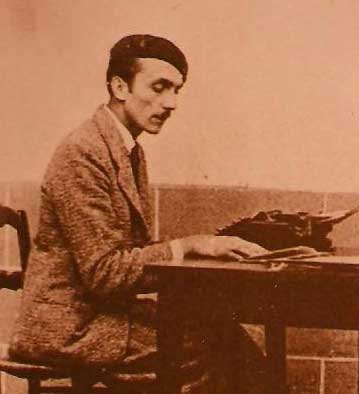 According to the resume Otto Rahn wrote for his SS entry dossier, he was born on 18 February 1904. Rahn’s school history teacher Freiher von Gaul introduced him to the Grail romances and the stories of Parzival and Siegfried. He gained his Bachelor degree in 1924. Rahn’s thesis was titled to the Research of Master Kyot of Wolfram von Eschenbach. He dedicated the work to the author of Parzifal, to Wagner and to the troubadours.
According to the resume Otto Rahn wrote for his SS entry dossier, he was born on 18 February 1904. Rahn’s school history teacher Freiher von Gaul introduced him to the Grail romances and the stories of Parzival and Siegfried. He gained his Bachelor degree in 1924. Rahn’s thesis was titled to the Research of Master Kyot of Wolfram von Eschenbach. He dedicated the work to the author of Parzifal, to Wagner and to the troubadours.
In March 1932 the Languedoc newspaper La Depeche du Midi published articles about the activities of a group of Polaires (a society linked to the Theosophical Society, particularly active in France and England) who were excavating the caves of Ussat and Ornolac near Montségur. Otto Rahn was said to be the leader of this group and suspicions were raised about his nationality. The first World War hadn’t done much for the reputation of German nationals. Antonin Gadal, a renowned historian and researcher of the Cathars wrote back in Rahn’s defense claiming he was a serious academic with a profound interest in the Cathars.
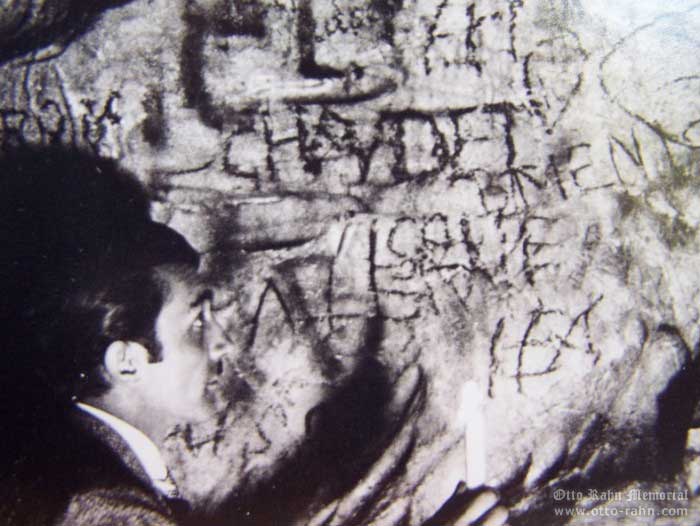 Speaking both French and the langue d’oc, Otto had come to the southern French Pyrenees in 1930, perhaps as early as 1929. He was specifically interested in the area around the castle of Montségur, convinced that it was Montsalvage, the Grail castle described by Wolfram Von Eschenbach. He explored the grottoes of the Sabarthes area, notably Ornolac and the massive cavern of Lombrives. It contained a huge chamber the locals called the Cathedral, a stalagmite called The Tomb of Hercules and another one called the Altar. These were all terms used by Von Eschenbach in his epic poem. Rahn discovered that the chambers in the cave of Sabarthes were covered with Templar symbols, side by side with Cathar emblems. It was in this cave Rahn discovered a mural of a bleeding lance. It was by this discovery that Otto attracted the attention of Heinrich Himmler, founder of the Nazi Group Ahnenerbe.
Speaking both French and the langue d’oc, Otto had come to the southern French Pyrenees in 1930, perhaps as early as 1929. He was specifically interested in the area around the castle of Montségur, convinced that it was Montsalvage, the Grail castle described by Wolfram Von Eschenbach. He explored the grottoes of the Sabarthes area, notably Ornolac and the massive cavern of Lombrives. It contained a huge chamber the locals called the Cathedral, a stalagmite called The Tomb of Hercules and another one called the Altar. These were all terms used by Von Eschenbach in his epic poem. Rahn discovered that the chambers in the cave of Sabarthes were covered with Templar symbols, side by side with Cathar emblems. It was in this cave Rahn discovered a mural of a bleeding lance. It was by this discovery that Otto attracted the attention of Heinrich Himmler, founder of the Nazi Group Ahnenerbe.
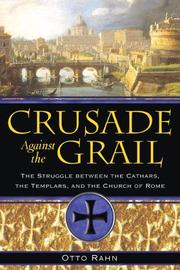 Rahn left France in 1932 to publish his first book Crusade against the Grail, the Struggle between the Cathars, the Templars, and the Church of Rome in Germany two years later. Rahn claimed Wolfram Von Eschenbach modelled the characters in Parzifal after real Middle Ages personalities. Parzifal was Count Raymond Trencavel of Carcassonne one of the foremost and heroic victims of the Crusade. Respanse de Joye was Esclarmonde of Foix. The hermit Trevrizent was the Cathar Bishop Guilhabert of Castres. King Anfortas was Raymond-Roger of Foix. Montségur was the castle of Montsalvage. Otto Rahn believed the Castle of Montségur was the Temple of the Grail.
Rahn left France in 1932 to publish his first book Crusade against the Grail, the Struggle between the Cathars, the Templars, and the Church of Rome in Germany two years later. Rahn claimed Wolfram Von Eschenbach modelled the characters in Parzifal after real Middle Ages personalities. Parzifal was Count Raymond Trencavel of Carcassonne one of the foremost and heroic victims of the Crusade. Respanse de Joye was Esclarmonde of Foix. The hermit Trevrizent was the Cathar Bishop Guilhabert of Castres. King Anfortas was Raymond-Roger of Foix. Montségur was the castle of Montsalvage. Otto Rahn believed the Castle of Montségur was the Temple of the Grail.
Rahn described the Grail consisting of several tablets of stone engraved with runic or even pre-runic inscriptions. He believed that it was either one perfect emerald with 144 facets or 144 engraved emerald tablets. This emerald would have graced the Crown of Lucifer symbolizing his third eye that fell to earth and touched ground on the Pog of Montségur. At the same time it seems from his writings that he perhaps considered the Grail to be a spiritual affair.
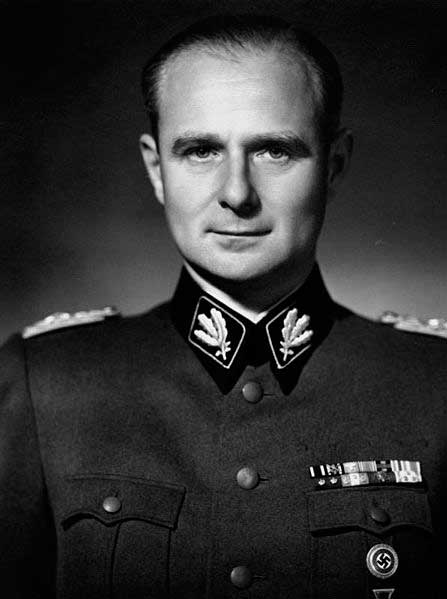 On 29 February 1936 SS General Karl Wolff wrote to the SS recuitment office to convey Heinrich Himmler’s personal instruction that Otto Rahn be admitted to his personal staff. It is generally believed Rahn wasn’t a convinced Nazi. Himmler was not a man whose offer one could refuse. He was under orders to deliver a book to Himmler by October 1937 and another in 1939. Himmler regarded Rahn as a very important member of the team. Himmler personally ordered one hundred copies of his 2nd book Lucifer’s Court and had one of the deluxe editions offered to Hitler himself.
On 29 February 1936 SS General Karl Wolff wrote to the SS recuitment office to convey Heinrich Himmler’s personal instruction that Otto Rahn be admitted to his personal staff. It is generally believed Rahn wasn’t a convinced Nazi. Himmler was not a man whose offer one could refuse. He was under orders to deliver a book to Himmler by October 1937 and another in 1939. Himmler regarded Rahn as a very important member of the team. Himmler personally ordered one hundred copies of his 2nd book Lucifer’s Court and had one of the deluxe editions offered to Hitler himself.
In 1937 Rahn was sent back to the Languedoc for a reason that never been clarified. He briefly stayed in Montségur and left stating he would be back in 1939. Local legend has it that it was during this trip he visited Rennes-le-Château on an expedition to find “forbidden merchandise”. In 1944 Otto Skorzeny’s soldiers would massacre the entire village of Oradour-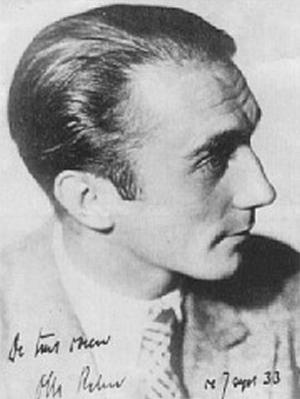 sur-Glame in search of this same thing described as “forbidden merchandise”.
sur-Glame in search of this same thing described as “forbidden merchandise”.
Rahn was dismissed from the SS on 17th March 1939, four days after his death. On May 18, 1939 Nazi newspaper Volkischer Beobachter published Rahn’s obituary signed Wolff SS-Gruppenfuhrer: “last March, SS-Obersturmfuhrer Otto Rahn tragically lost his life in a mountain snowstorm. We weep for our late comrade, an honest man of the SS and an excellent author of historical and scientific works.” It is assumed Otto Rahn committed suicide but this was never confirmed. He was still working on several books at the time.
Many thanks to Vitaliy Lozovskiy of www.otto-rahn.com for making his research available. You will find everything there is to know about Rahn on his excellent website.
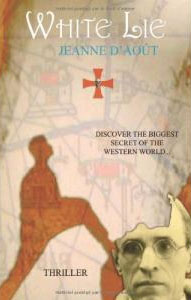 The facts and a thrilling hypothesis about Otto Rahn’s life have been magically blended into a Da Vinci Code-style page turner of a novel by the talented Jeanne d’Aout. You should definitely read her book White Lie.
The facts and a thrilling hypothesis about Otto Rahn’s life have been magically blended into a Da Vinci Code-style page turner of a novel by the talented Jeanne d’Aout. You should definitely read her book White Lie.


It’s nice to see Otto Rahn finally getting some of the recognition he deserves. At the risk of coming across as a nit picker I would like to clarify a few points raised in your otherwise excellent article.
( 1 ) Otto wasn’t introduced to the Grail romances by his mother Clara. In fact his relationship with his mother was a notoriously difficult one. A great many folk, his niece Ingeborgh Roemer-Rahn among them, believe it may have been his lack of love and acceptance as a child that created the psychological underpinnings of his later quest in the South of France. He first learned of the myth complex surrounding the Holy Grail and was inspired by tales of the Albigensian crusade related to him by his beloved school history teacher Freiher von Gaul.
( 2 ) Otto was already in Montsegur by 1930 and may have first visited the South as early as 1929
( 3 ) The mural ( rather than a carving ) of the bleeding lance mentioned in the article actually has nothing to do with Otto. It was found in a small cave in the cliffs above Vicdessos ( directly below the ruins of the castle of Montrealp-de-Sos by one of Gadal’s principal rivals, Joseph Mandement the President du Syndicat d’initiative of Tarascon. Deodat Roche championed the mural as evidence for the practise of Mithraism in the area and Antonin Gadal later appropriated the design for the cover of his book ‘On the path to the Holy Grail’. I believe it was Christian Bernadac who erroneously connected Otto to the story of the ‘bleeding spear’ in his highly fanciful and wildly inaccurate tome ‘Montsegur et le Graal – Le mystere Otto Rahn’. The mural itself is believed by many to be of relatively recent origin and although it can still be viewed today it has faded dramatically since Mandemant’s ‘discovery’ in the summer of 1932 – shortly after Otto had already departed from France.
( 4 ) The photograph of the figure standing in the pentagram at Bethlehem Grotto shows a man named Karl Rinderknecht – not Otto Rahn. This still was passed on to me in 1998 by Paul Ladame who deliberately misidentified the figure in the pentagram as his ‘friend’ Otto Rahn – apparently in an effort to bolster his claims that Otto was an initiated Rosicrucian. It has since been widely reproduced and equally widely misattributed.
( 5 ) While Otto certainly seems to have made excavations at some of the sites, including Fontanet and the Cave of the Hermit, he makes it abundantly clear in his surviving work that his ‘Grail’ was a spiritual Grail rather than any material treasure. In ‘Court of Lucifer’ he pokes gentle fun at the other ‘treasure hunters’ digging up Montsegur at the time before returning to his central theme, the illumination of an ancient and all but forgotten belief system.
Once again let me congratulate you on your article which provides a very solid introduction to Otto’s curious life and work. As Christian Bernadac put it when I interviewed him in 1998 “Otto Rahn is an enigma – an enigma wrapped up in a mystery.” It’s satisfying to know that his legacy lives on…
Hey Richard, thanks for dropping by and taking the trouble to comment. It’s much appreciated. I’ll have a look and adjust the article!
Take care | Raven
Is it alright to put a portion of this in my site if perhaps I submit a reference point to this web-site?
Yes that’s perfectly ok as long as you include a link to https://www.renneslechateau.nl | All there is to know about Rennes-le-Château.
Thanks for your interest!
Although I truly like this publish, I believe there was an spelling error close to the end from the 3rd section.